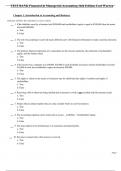Exam (elaborations)
Test Bank For Financial & Managerial Accounting 16th Edition by Carl Warren, Jefferson Jones, William Tayler. Isbn. 9780357714041
- Course
- Institution
Test Bank Financial & Managerial Accounting 16th Edition by Carl Warren, Jefferson Jones, William Tayler. Isbn. 9780357714041. 9798214343747. Financial and Managerial Accounting 16e test bank. Warreb 16e test bank for Financial & Managerial Accounting. Contents:-=•Introduction to Accounting and...
[Show more]



